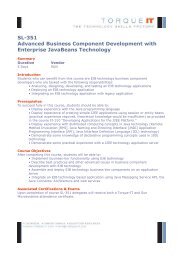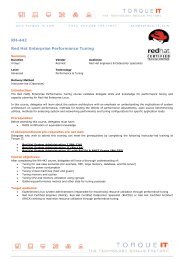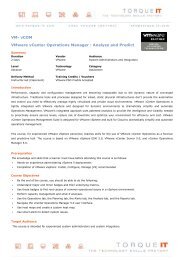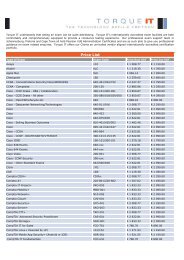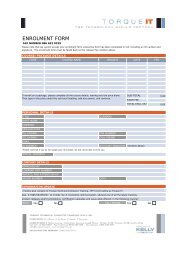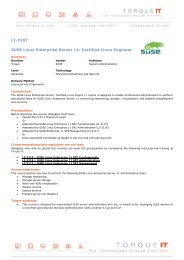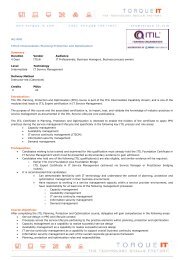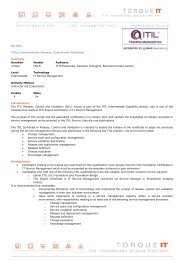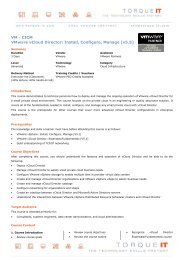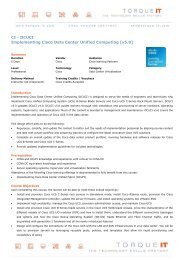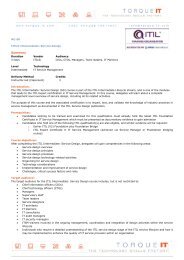CH â CSCU EC-Council Certified Secure Computer User - Torque IT
CH â CSCU EC-Council Certified Secure Computer User - Torque IT
CH â CSCU EC-Council Certified Secure Computer User - Torque IT
- No tags were found...
You also want an ePaper? Increase the reach of your titles
YUMPU automatically turns print PDFs into web optimized ePapers that Google loves.
<strong>CH</strong> – <strong>CSCU</strong><strong>EC</strong>-<strong>Council</strong> <strong>Certified</strong> <strong>Secure</strong> <strong>Computer</strong> <strong>User</strong>SummaryDuration Vendor Audience2 Days hands-on training <strong>EC</strong>-<strong>Council</strong> Security BeginnersLevel Technology CategoryEntry - Level Ethical Hacking Ethical Hackers / <strong>Secure</strong> <strong>Computer</strong> <strong>User</strong>sDelivery MethodInstructor-led (Classroom)Training Credits / VouchersN/AIntroductionThe purpose of the <strong>CSCU</strong> training program is to provide students with the necessary knowledge and skills to protect theirinformation assets. This class will immerse students into an interactive environment where they will acquire fundamentalunderstanding of various computer and network security threats such as identity theft, credit card fraud, online banking phishingscams, virus and backdoors, emails hoaxes, sex offenders lurking online, loss of confidential information, hacking attacks andsocial engineering. More importantly, the skills learnt from the class helps students take the necessary steps to mitigate theirsecurity exposure.PrerequisitesBasic computer literacyBasic PC operating system navigation skillsBasic Internet usage skillsBasic IP address knowledgeCourse ObjectivesUpon completing this course, the learner will have an understanding of the following: Personal <strong>Computer</strong> Security Passwords Social Engineering Identity Theft Email Security Safe Browsing Data Protection Encryption Physical Security Online Transactions Security Digital Signature & Certificates Data Backup Social Networking Antiviruses Protection Disaster Recovery Internet Security
Credit Card FraudsMonitoring Kids onlineWireless & Home Network SecurityBluetooth SecuritySmartphone SecurityMobile Device SecurityWindows OS & Mac OS X SecurityComplianceTarget AudienceThis course is specifically designed for todays' computer users, who use the internet and the world wide web (www) extensivelyto work, study and play.Course Content1. Foundations of Security Essential Terminologies <strong>Computer</strong> Security Why Security? Potential Losses Due to SecurityAttacks Elements of Security The Security, Functionality, andEase of Use Triangle Fundamental Concepts ofSecurity Layers of Security Security Risk to Home <strong>User</strong>s What to <strong>Secure</strong>? What Makes a Home <strong>Computer</strong>Vulnerable? What makes a System <strong>Secure</strong>? Benefits of <strong>Computer</strong> SecurityAwareness Basic <strong>Computer</strong> SecurityChecklist Enable BitLocker in Windows 7 Launching Event Viewer inWindows 7 Disabling Unnecessary Servicesin Windows 7 Killing Unwanted Processes Finding Open Ports UsingNetstat Tool Configuring Audit Policy How to Hide Files and Folders? Disable Simple File Sharing inWindows Raise the UAC Slider Bar inWindows 7 Windows Security Tools Guidelines for Securing Mac OSX Operating Systems SecurityChecklist Security Checklist for Windows 7 MAC OS Security Checklist Choosing the Best AntivirusSoftware Steps to Install Antivirus onYour <strong>Computer</strong> How to Test If Antivirus IsWorking Configuring McAfee Antivirus Configuring Kaspersky PURE Antivirus Security Checklist4. Data Encryption Common Terminologies What is Encryption? Objectives of Encryption Usage of Encryption Types of Encryption Encryption Standards Digital Certificates How Digital Certificates Work? Digital Signature Cryptography Tools2. Securing Operating Systems System Security Threats to System Security Guidelines for Windows OSSecurity Windows Encrypting File System(EFS) Using Windows Defender3. Protecting System UsingAntiviruses Introduction to AntivirusSoftware Need for Antivirus Program How Does Antivirus SoftwareWork? Antivirus Software 20115. Data Backup and DisasterRecovery Data Backup Need for Backup Types of Data Loss What Files to Backup and HowOften? Online Data Backup
Online Backup Service Providers Types of Backup Back Up the Data UsingWindows Backup Securing Backup on StorageDevices with Encryption Time Machine (Apple Software) Data Backup Tools for Windows Data Backup Tools for MAC OS X Data Recovery Tools forWindows MAC OS X Data Recovery Tool Physical Security Data Backup Checklist Physical Security Checklist6. Internet Security Internet Security Internet Explorer SecuritySettings Understanding Cookies Internet Explorer PrivacySettings Securing File Downloads Mozilla Firefox Security Settings Mozilla Firefox: Privacy Settings Securing File Downloads Installing Plugins Google Chrome Privacy andSecurity Settings Apple Safari Security Settings Testing the Browser for Privacy Instant Messaging (IMing) Searching the Web Online Gaming and MMORPG Protection Schemes, CyberProstitution, and Virtual Mugging How the Malicious <strong>User</strong>s MakeMoney? Security Practices Specific toGaming Management Child Online Safety Misdirected Searches Stealth Sites and MisleadingURLsChild Pornography, Grooming,and CyberbullyingRole of Internet in ChildPornographyUnsolicited EmailsChat RoomsFinding if Children are at RiskOnlineProtecting Children from OnlineThreatsEncourage Children to ReportHow to Report a Crime?Security Software ChecklistActions to Take When the ChildBecomes an Online VictimInternet lawsLaws Internet users shouldknowHighlights of DMCAInternet Security ChecklistGuidelines for Parents to ProtectChildren from Online Threats7. Securing Network ConnectionsHome NetworkWireless NetworksChanging Wireless NetworkingConfiguration in Windows 7Changing Wireless NetworkingConfiguration in MacCommon Threats to WirelessNetworkSecuring Wireless NetworkUsing the Network with Windows7Using the Network with MAC OSXNetwork Security ThreatsSecuring Network ConnectionsGeneral Security Practices inHome NetworkingNetwork AdaptersTroubleshooting with NetworkAdaptersNetwork Security Checklist8. Securing Online Transactions Online Shopping Online Banking Credit Cards Payments Types of Credit Card Frauds Guidelines for Ensuring CreditCard Safety Securing Online Transactions Online Payment Services SSL and the Padlock Symbol Identifying a TrustworthyWebsite Identifying an UntrustworthyWebsite McAfee’s Site Advisor Online Transactions SecurityChecklist9. Securing EmailCommunications Email Security Email Security Threats Email Attachments: Caution Spamming Countermeasures Anti-Spamming Tool Nigerian Scam Email Security Procedures How to Obtain DigitalCertificates? Installing Digital Certificate Signing your Emails Online Email Encryption Service Email Security Tools Email Communication Checklist Email Security Checklist Security Checklist for CheckingEmails on Mobile10. Social Engineering andIdentity Theft What Is Identity Theft? Social Engineering <strong>Computer</strong>-Based SocialEngineering: Phishing Phony Security Alerts
How to Learn if You Are a Victimof Identity Theft What to Do if Identity Is Stolen Reporting Identity Theft Prosecuting Identity Theft Protecting from Identity Theft Identity Theft ProtectionChecklist <strong>Computer</strong> Based Identity TheftProtection Checklist11. Security on SocialNetworking Sites Social Networking Sites What Is a Profile? Top Social Networking Sites Security Risks Involved in SocialNetworking Sites Social Networking Threats toMinors Facebook Privacy Settings Staying Safe on MySpace Social Networking SecurityChecklist Social Networking SecurityChecklist for Parents andTeachers12. Information Security andLegal Compliance HIPPA FERPA PCI DSS13. Securing Mobile Devices Mobile Device Security Mobile Phone Services IMEI Number Mobile Device Security Risks Threats to Bluetooth Devices Mobile Security Procedures Securing iPhone and iPad Securing Blackberry andWindows Phone 7 Mobiles Mobile Security Tools Bluetooth Security Checklist Mobile Phone Security ChecklistAssociated Certifications & ExamStudents will be prepared for <strong>EC</strong>-<strong>Council</strong>'s <strong>CSCU</strong> exam 112-12*. This certification is an excellent complement to educationalofferings in the domain of security and networking. Educational institutions can provide greater value to students by providingthem not only with one of the most updated courseware available today but with a certification that empower their students inthe corporate world. The courseware comes complete with labs and exercises to allow the student to gain actual skills.On successful completion of this course students will receive a <strong>Torque</strong> <strong>IT</strong> attendance certificate.*When you attend any authorized <strong>EC</strong> <strong>Council</strong> training course at <strong>Torque</strong> <strong>IT</strong> you will receive the associated Prime IBT examinationvoucher as part of your course material. Your certification examination voucher can be used to book and pay for yourcertification examination at an Authorized <strong>EC</strong> <strong>Council</strong> Testing Center (ETC) only. If you are not able to sit your certificationexamination at <strong>Torque</strong> <strong>IT</strong>, and you have no other ETC locally available, you do have the ability to convert your Prime IBTexamination voucher into a Pearson VUE examination voucher, at an additional cost of USD100.



